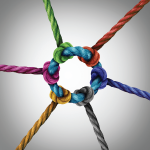My colleagues demonstrated an openness, not only to share these examples with us, but also to question their preconceived ideas. They serve as role models for us in their willingness to become self-aware and to take a corrective course when unconscious bias is brought to their attention. It begins with awareness.
We Can Work to Stop Bias in Our Practices
The ACR has taken a leadership role in bringing attention to this issue. Thanks to the vision and commitment of past president and ACR master David Wofsy, public health researcher and Atlanta rheumatologist Sam Lim, and ACR staff members Lisa Amaker, Sheryl McCalla, and Robin Campbell, we’re off to an impressive start. With a grant from the United States Department of Health and Human Services’ Office of Minority Health, and a charter to reduce health disparities in lupus care, the ACR’s Lupus Initiative is developing critically important educational tools and resources.
This month, The Lupus Initiative is launching a curriculum and a suite of resources designed to bring attention to health care disparities, including the effects that conscious and unconscious bias can have on patient care. The Lupus Initiative partnered with Georgetown University’s National Center for Cultural Competence to create an online CME series titled, Conscious and Unconscious Biases in Healthcare: Focus on Lupus. The series provides a wealth of thought-provoking essays and tools that you can use to assess your level of unconscious bias. It also provides a set of simple steps that providers can take to bring awareness to bias and mitigate its effects. The new CME series will assist you in getting started and creating an action plan for tackling this very important issue. You can access this online CME at www.thelupusinitiative.org. Some initial steps that you can take include:
- Acknowledge and accept the existence of bias, its manifestations, and its effects.
- Know that biases can be interrupted.
- Assume individual responsibility to address bias without assignment of guilt or blame.
- Engage in self-reflection and self-assessment.
Most of us are aware that health disparities exist. It is a complex issue, with many factors accounting for disparities in outcomes. As healthcare professionals, it is our responsibility to strive for unbiased care, minimizing and hopefully eliminating bias as a factor that may lead to health disparities. When we equip ourselves and our staffs to be alert to the potential for bias and its effects, we can provide better care and help our patients achieve better outcomes. We may discover that a patient who did not follow through on a course of treatment was not willfully noncompliant, but failed to understand instructions because of a language barrier; perhaps they needed a translator. Or perhaps they speak the same language you do but needed the information communicated differently, by a person with whom they feel comfortable.


